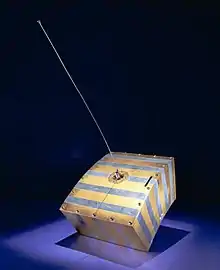AMSAT-OSCAR 6
AMSAT-OSCAR 6 (a.k.a. AO-6) was the first Phase 2 amateur radio satellite (P2-A) launched into low Earth orbit. It was also the first satellite constructed by the new AMSAT North America (AMSAT-NA) organization.
| Names | AO-6 |
|---|---|
| Mission type | Amateur radio |
| Operator | AMSAT / NASA |
| COSPAR ID | 1972-082B |
| SATCAT no. | 6236 |
| Mission duration | 4.5 years (achieved) |
| Spacecraft properties | |
| Bus | AMSAT-OSCAR |
| Manufacturer | AMSAT-NA |
| Launch mass | 18.2 kg (40 lb) |
| Dimensions | 16 cm × 30 cm × 44 cm (6.3 in × 11.8 in × 17.3 in) |
| Power | 3.5 watts |
| Start of mission | |
| Launch date | 15 October 1972, 17:19 UTC |
| Rocket | Delta 300 (Delta 91 / Thor 575575) |
| Launch site | Vandenberg, SLC-2W |
| Contractor | Douglas Aircraft Company |
| End of mission | |
| Last contact | 21 June 1977 |
| Orbital parameters | |
| Reference system | Geocentric orbit [1] |
| Regime | Low Earth orbit |
| Perigee altitude | 1,448 km (900 mi) |
| Apogee altitude | 1,457 km (905 mi) |
| Inclination | 101.70° |
| Period | 114.93 minutes |
Launch
The satellite was launched 15 October 1972, by a Delta 300 launcher from Vandenberg Air Force Base, Lompoc, California. AO-6 was launched piggyback with NOAA-2 (ITOS-D).
Spacecraft
AMSAT-OSCAR 6 was box-shaped, measuring 43 cm × 30 cm × 15 cm, with a mass of 18.2 kg. It had a near-circular polar orbit of 1448 × 1457 km with an inclination of 101.70°. It deployed two quarter-wave monopole antennas, one each for 144 and 435 MHz, and half-wave dipole antenna for 29 MHz. It remained operational for 4.5 years until a battery failure on 21 June 1977.[2][3]
Equipped with solar panels powering NiCd batteries, AO-6 provided 24 V at 3.5 watts power to three transponders. It carried a Mode A transponder (100 kHz wide at 1 watt) and provided store-and-forward morse and teletype messages (named Codestore) for later transmission. Subsystems were built in the United States, Australia, and Germany.[4]
AO-6 had a 1.3 watt transmitter into a half-wave dipole antenna. AO-6's receiver input sensitivity was approximately -100 dBm (2 μV per meter) and had an Automatic gain control (AGC) that provided up to 26 dB of gain reduction optimized for single-sideband modulation. The transceiver team consisted of Karl Meinzer DJ4ZC, Wallace Mercer W4RUD, Dick Daniels WA4DGU and Jan King W3GEY.
Firsts
AO-6 demonstrated several uses of new technologies and operations.[4]
- First complex control system using discrete logic
- First satellite-to-satellite relay, through AO-7.[5]
- Demonstrated usage of satellite enabled doppler-location of ground station for search and rescue;
- Demonstrated practical, low-cost medical data relay from remote locations.
See also
References
- McDowell, Jonathan. "Satellite Catalog". Jonathan's Space Page. Retrieved 16 June 2013.
- "AMSAT P2A". Gunter's Space Page. 31 December 1999. Retrieved 12 February 2013.
- "Oscar 6 1972-082B". NASA. 14 May 2020. Retrieved 7 January 2021.
 This article incorporates text from this source, which is in the public domain.
This article incorporates text from this source, which is in the public domain. - "AMSAT-OSCAR 6 Satellite Summary". AMSAT. 31 May 2003. Archived from the original on 18 June 2010. Retrieved 11 February 2013.
- Klein, Perry (October 1975). "Intersatellite communication using the AMSAT-OSCAR 6 and AMSAT-OSCAR 7 radio amateur satellites". IEEE Proceedings. IEEE. 63 (10): 1526–1527. Bibcode:1975IEEEP..63.1526K. doi:10.1109/PROC.1975.9988.
- Jan King, "The Sixth Amateur Satellite - A Technical Report: Part I," QST, Jul 1973, p. 66-71, 101.
- Jan King, "The Sixth Amateur Satellite - A Technical Report: Part II," QST, Aug 1973, p. 69-74, 106.
- John Fox and Ron Dunbar, "Preliminary Report on Inverted Doppler Anomaly," ARRL Technical Symposium on Space Communications, Reston, VA, Sep 1973, pp 1–30.
- Perry Klein and Jan King, "Results of the AMSAT-OSCAR 6 Communications Satellite Experiment," IEEE National Convention Record, NYC, Mar 1974.
- Perry Klein and Ray Soifer, "Intersatellite Communication Using the AMSAT-OSCAR 6 and AMSAT-OSCAR 7 Radio Amateur Satellites," Proceedings of the IEEE Letters, Oct 1975, pp 1526–1527.
- D. Brandel, P. Schmidt, and B. Trudell, "Improvements in Search and Rescue Distress Alerting and Location Using Satellites," IEEE WESCON, Sep 1976.
- J. Kleinman, "OSCAR Medical Data," QST, Oct 1976, pp 42–43.
- D. Nelson, "Medical Relay by Satellite," Ham Radio, Apr 1977, pp 67–73.
- W0LER, "OSCAR 6 - Gone but not forgotten," QST, Nov 1977, p. 31.
